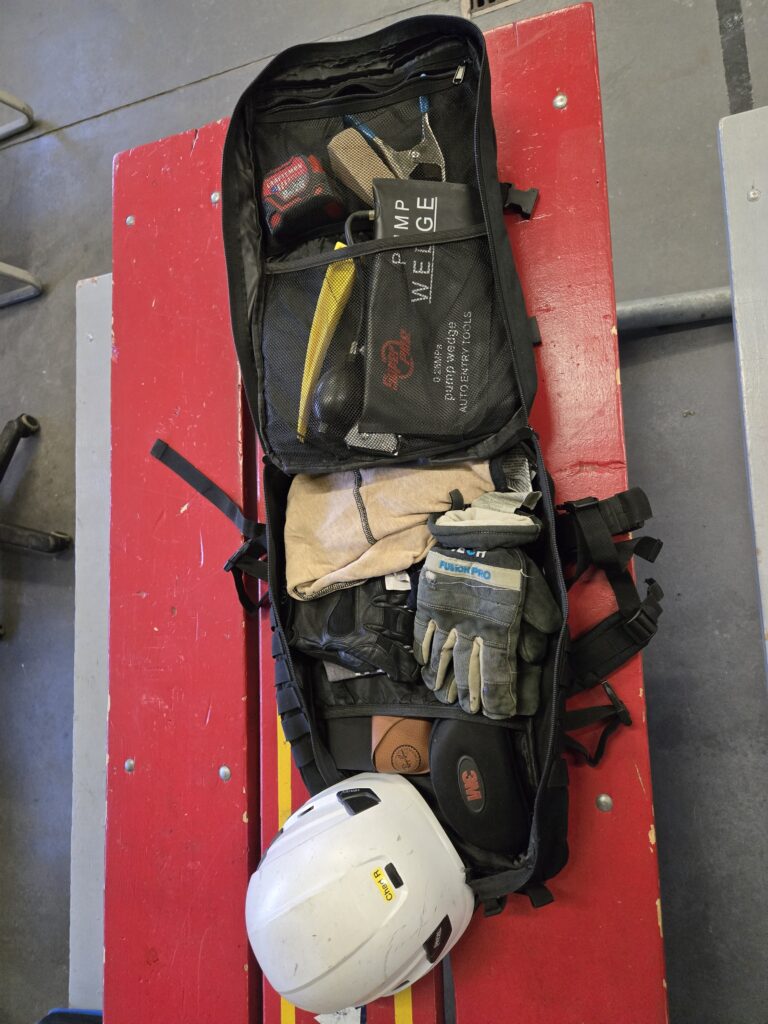
Technical response: How to avoid overpacking – Streamlining your gear for every call
By Chad Roberts
Features Equipment Extrication Image 1.
Photo credit: Chad Roberts
Image 1.
Photo credit: Chad Roberts Way too much stuff! Is it needed? What can and can’t you live without?
This dilemma is all too real for modern air travelers who are trying to avoid charges and travel more efficiently.
So, what does this have to do with tech rescue? The point I’m trying to address concerns collective tools and carry-on baggage we keep in our pockets. While earlier in your career, there was a handful of things you could get away with. But how about those positioned on a rescue, squad, or any other station that requires you to respond to multiple disciplines, all requiring a caveat of different PPE, equipment and any other trinkets you can’t live without? And in the dead of winter, it is a great time to empty your pockets and see what is genuinely needed. The following suggestions have helped me through my career and time on a rescue truck, but by no means is this etched in stone.

Image 2.
Photo credit: Chad Roberts
So, let’s break it down quickly and simply, as there is a lot of ground and gear to cover. I like to have rope gear set up together for tech rescue calls, such as rope/confined space/trench. A helmet, gloves, field guide and a buff are needed to protect against elements such as UV and bugs (see image 1). For cold weather, keep extras of everything. At the bare minimum, have an extra shirt, socks, flash hood and pair of structural fire fighting gloves for those long nights at a call. When it comes to extrication, my tool chest is significant, as it can apply to many different functions; therefore, I put this cache of equipment in a small tool that fits easily into my turnout pants pocket. Some of my key items are a small pry bar, a 10 mm wrench for 12v battery disconnects, and a small screwdriver for accessing and enabling most vehicle shift locks so we can put them into and out of gear without vehicle power (see image 2).

Image 3.
Photo credit: Chad Roberts
Now that I’ve discussed some different tools for your varying disciplines let’s finish up by talking a little about transport. The assumption that I will need to have every tool for all situations is not realistic and will only add weight and confusion. I suggest breaking your gear down into a personalized and organized kit for specific uses so you can adjust quickly while en route to a call. In my smaller pouches, I break it down into two different sections. The first one has two pieces of tubular webbing and two carabiners. This never leaves my side pocket, no matter what type of call. I keep spring-loaded wire cutters and a couple of wedges in that same left-side pocket (left for life). The other smaller pouch is where I keep my tools required for auto ex, man and machine, and other heavy rescue calls (see image 3).
While this may seem like a lot—you’re probably right—it could be worse. Ultimately, what you need to carry will depend on your needs and the types of calls you run in your area. However, the one constant you must stress is how to organize these different disciplines into one easily accessible bag on the truck. Any tactical bag or large tool pouch will suffice to properly allow you to choose the right tools for the call you are responding to (see image 4).

Image 4.
Photo credit: Chad Roberts
All in all, you have to make it work for you and the types of responses you will be attending. Every year, we learn new tricks of the trade from members we work with, classes or articles like this. As mentioned earlier, these suggestions are merely that. If you have something that works for you, don’t throw it aside and definitely don’t keep it a secret. Please keep spreading the word in this great network; we have to help one another. Be mindful of your personal tool list, as it can grow and become overwhelmingly heavy and unrealistic.
So, take some time, get out there, and audit your carry-on.
Chad Roberts is an Acting Captain on a Heavy Rescue in Oakville, Ont. He is a member of the Oakville Extrication Team and Vice President of the North American Vehicle Rescue Association. He also instructs at various colleges throughout Ontario and is a current member of the Canadian Motorsports Response Team. Contact Chad at chadroberts12@gmail.com.